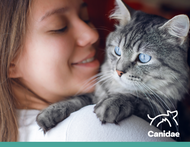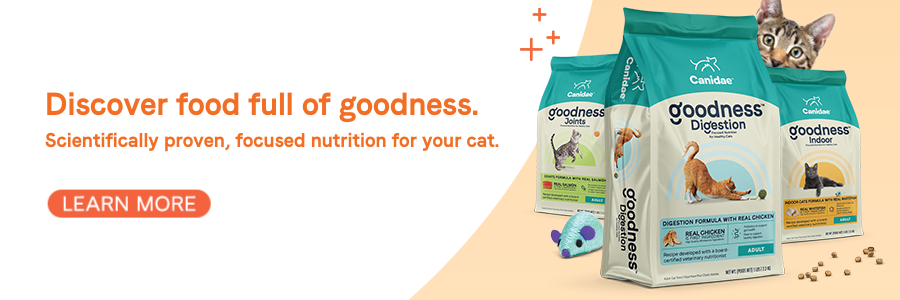Kidney Disease In Cats: Causes, Symptoms, Treatment and Food
You’ve probably noticed some human-like behaviors in your cat before. Perhaps they get moody when things don’t go their way, or maybe they show a bit more love and affection when you’re feeling low. Regardless of their personality, one thing that’s for sure is that just like humans have complex bodies, cats do too — and unfortunately this means a variety of things can go wrong. While kidney disease may only affect 1-3% of cats, its prevalence increases with age — as many as 30% to 50% of cats older than 15 years of age have chronic kidney disease.
While this may be alarming to hear, the good news is that cats can live comfortably for years with kidney disease if it is caught early and treated appropriately.
It’s easier to catch kidney disease early if you’re aware of the causes and symptoms. Let’s take a look at what those are, plus what to do if your cat has been diagnosed.
What is kidney disease?
To understand kidney disease it’s important to first get to grips with what the kidneys do. They are perhaps most well known for removing toxins through urine — separating the chemicals you want to keep in your body from those you need to dispose of, and dissolving them in water to make urine. However, their purpose is not limited to this, and includes:
- Managing blood pressure
- Conserving the body’s water
- Conserving proteins
- Making hormones
- Stimulating bone marrow to produce red blood cells
- Balancing levels of calcium and phosphorus
- Balancing levels of sodium and potassium
- Balancing pH levels
When the kidneys’ ability to carry out these functions falters, it could be a sign of kidney disease.
There are two types of kidney, or renal, disease in cats. Acute renal failure develops suddenly and is often prompted by factors such as poisoning, trauma, or infection. Thankfully for your cat or kitten it might be reversed if diagnosed and treated in time.
Unfortunately, chronic kidney disease (CKD) can be harder to treat as it develops over a longer period of time and is often undetected until later stages, when the cat may only have days or weeks to live. Don’t despair though… Cats with chronic kidney disease can live fulfilling lives if their condition is kept under control.
The International Renal Interest Society (IRIS) have created a scale to help categorize cats with CKD. Stage I covers pets with evidence of kidney disease but no actual change in kidney function, and the severity increases stage-by-stage up to Stage IV, where pets feel unwell and can eventually suffer late stage kidney failure.
What causes kidney disease in cats?
While cats’ kidneys often begin to fail with age, it is also true that kittens can be born with kidney disease. While the exact causes for CKD aren’t always clear, they may include advanced dental disease, high blood pressure, thyroid problems and cancer. It’s even possible that infections and blockages can wear down kidney function at a low level for months or years.
It’s important to take your cat or kitten to the veterinarian for frequent checkups; remember, even with a CKD diagnosis your pet can have a relatively high quality of life.
What are the symptoms of kidney disease in cats?
While it’s always essential you take your pet to a veterinarian if you believe it is sick, these are a few of the key things to keep an eye on that may suggest your cat’s kidneys aren’t working perfectly:
- Frequent urination or urination outside of the litter box
- Drinking more water than usual
- Decreased appetite and subsequent weight loss
- Vomiting or diarrhea
- Bloody or cloudy urine
- Mouth ulcers
- Bad breath with an ammonia-like odor
- Discoloration of the tongue
- Constipation
- Weakness and indifference
Diagnosing CKD in cats
The usual process for detecting CKD involves blood and urine tests, but can also extend to different types of scans (X-rays, ultrasounds, etc.) and occasionally biopsies to check tissue.
The good news for you and your cat is medical advancements mean vets can now diagnose CKD earlier. If kidney disease is detected in IRIS stages 1 and 2 — before cats have shown any major symptoms — then the condition is a lot easier to manage.
How to manage and treat a cat with CKD
In some cases treatments such as surgery to remove blockages and IV fluids are necessary, however in a lot of cases, effective monitoring and management is all that is needed to give your cat a good quality of life for many years to come.
Nutritional management is a very important part of this. Making alterations to a cat’s diet can help to correct imbalances and slow the progression of CKD — while making sure its body is still in tip-top shape.
People often wonder what to feed a cat with kidney disease. A diet specially designed for a cat with CKD is often known as a “renal diet”.
What is a renal diet?
A renal diet is designed to reduce uremic toxins, control high blood pressure, maintain an adequate calcium/phosphorus balance and levels of potassium, and reduce inflammation.
Such diets are considered the “gold standard” therapy for managing cats with CKD. The IRIS Board suggests these diets should be considered for cats at CKD stage II and recommended for cats at stages III and IV. Your vet will be able to advise you if a diet change is necessary for your pet, and if so, at which stage to implement it.
Let’s look at a few of the key elements of a renal diet.
Phosphorus reduction
Phosphorus could be described as the most important part of a renal diet. Phosphorus enters the cat’s body through food and leaves through the kidneys, but consuming too much of it has been linked to progression of CKD.
Reducing the amount of phosphorus in your cat’s diet can help, and there are even some low phosphorus cat foods for kidney disease, but it is important to ask for a vet’s guidance — no two cats are alike!
In some cases cats may even be prescribed medication such as a phosphate binder to help further reduce the levels of phosphorus in their blood.
Potassium supplementation
Cats with CKD often don’t have enough potassium and as a result may lose muscle strength and energy. While there are medications that help to conserve potassium, it is also possible to simply maintain potassium levels with adjustments to your cat’s diet.
Sodium reduction
Diets high in salt can increase blood pressure and worsen kidney damage, so renal diets often attempt to reduce your cat’s salt intake.
It’s also worth remembering that commercial cat treats can contain high levels of salt, so make sure to ask your vet before giving your pet a treat!
Omega-3 Fatty Acids
The good news is that your cat’s favorite food also has medicinal properties — fish are rich in omega-3 fatty acids. While some humans may feel queasy about taking fish oils, for cats it certainly won’t be a problem. Studies suggest kidney disease suffering cats which take omega-3 fatty acids are likely to live longer.
Make sure to talk to your vet to work out exactly which oil, and how much of it, is right for your cat.
Protein reduction?
The issue of protein reduction in renal diets remains a controversial one. Protein is a significant source of phosphorus in foods, so limiting it has long been a strategy to reduce phosphorus levels. Critics say cats on a lower protein diet can gain too much fat, which can cause other health problems. Even among supporters of protein reduction there has been a lot of debate as to which IRIS CKD stage is the right moment to begin a change of diet.
In recent times opinions have been changing and some vets believe without evidence that dietary protein reduction slows progression, the goal should be “to feed a level of protein that meets the cat’s needs while minimizing phosphorus.”
Does a renal diet work?
Some studies suggest it does. One study took 50 cats with naturally occurring renal failure and gave half of them a renal diet and the other half their regular food. The cats on the renal diet survived over twice as long as the others.
Another study in the Netherlands found cats on a renal diet lived for over 16 months compared to only 7 months for cats who continued with their usual diet.
Still, it’s crucial you check with your vet before making any changes to your cat’s diet. Before buying a generic food for cats with kidney disease make sure to speak to a professional. Like any other type of therapy, dietary therapy should be tailored to the individual cat’s needs, and you know better than anybody how unique your cat is.
Preventing kidney disease in cats
Unfortunately, CKD in cats is often genetic and may be inevitable as your cat gets older. Despite this it is important to look after your cat by:
- Taking it for regular check-ups at the vet
- Keeping an eye on any changes in its behavior or appearance
- Feeding it a balanced diet
For cat food that is packed full of healthy ingredients… CANIDAE® is developed in partnership with a board-certified veterinary nutritionist. No fillers, no artificial flavors or artificial preservatives, just complete & balanced goodness.
Whether it’s wet food or dry food, there’s something for every cat. Why not try our CANIDAE Grain-Free PURE Limited Ingredient Chicken Recipe Dry Cat Food?
Discuss transitioning your cat to one of Canidae’s delicious and healthy recipes today.



